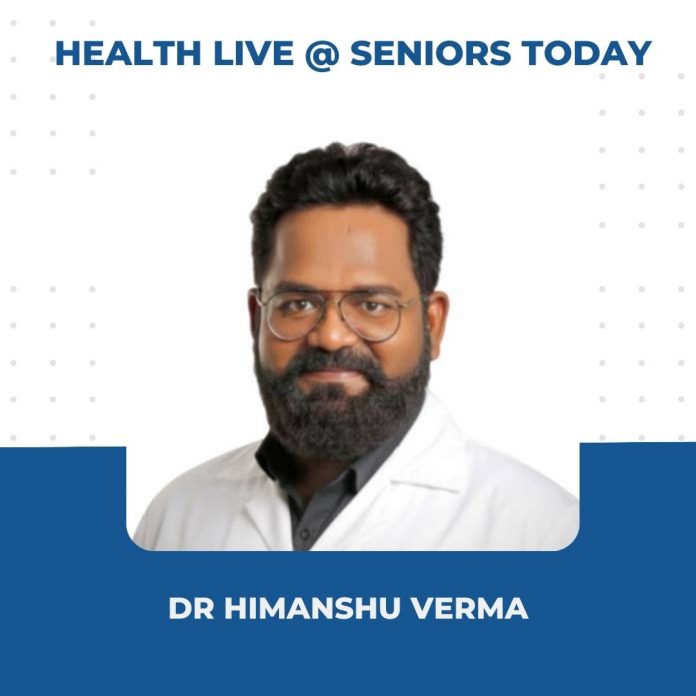On March 12, 2022 Seniors Today hosted its weekly Health Live Webinar. Keeping in mind that the month of March is observed as Deep Vein Thrombosis month, this week we had with us Dr Himanshu Verma who spoke on and answered questions about Deep Vein Thrombosis and Vascular Care for Seniors.
Dr Himanshu Verma is a senior vascular and endo-vascular surgeon with the Fortis Memorial Research Institute, Gurugram. He is a doctor on the panel of Health Assist.
He has experience at leading medical centres in India and the US (Mayo) in treating various complex vascular diseases using both endovascular (minimally invasive) and open surgical techniques. His clinical focus is on the treatment of aortic aneurysms, redo i.e. previously failed vascular procedures, peripheral gangrene, varicose vein and diabetic foot etc. He is an expert in performing complex vascular surgeries under local anesthesia and thereby reducing procedure associated risks and stay in hospital. An award winning doctor, Dr Verma has also performed more than 3000 complex AV fistula surgeries for dialysis patients. He has an avid interest in being up to date with recent developments in Vascular surgery and to his credit has over 40 publications including 9 book chapters and more than 25 presentations in prestigious national and international forums.
D-dimer has been the test related to deep vein thrombosis.
It is NOT used to diagnose DVT, it is only used to rule it out.
If you compare blood to milk- freshly clotted blood is equivalent to curd, it’s solid but soft. If you take the same curd and place it in a bowl and leave it out for a week or 2, eventually the water content will dry out- and that is what happens to a clot as it ages. And this is how a clot progresses- when a fresh clot is formed, it is soft but solid and when it becomes 2-3 weeks, a month old, a year old, so on and so forth- it becomes harder.
We have 2 kinds of blood vessel systems in the body. The heart pumps blood out to the body via arteries. Veins bring the blood back to the heart.
The structure of the body’s veins, specially in the leg is:
- Superficial- They are closer to the skin. You can sometimes see green veins or some bulging veins.
- Deep- they are nearer to the bones.
Any situation or cause that may lead to clotting of blood in the deep veins is called Deep Vein Thrombosis
DVT (Deep Vein Thrombosis) is a very common cause of sudden deaths.
DVT in some cases is either partially managed, mismanaged in some and over managed in others.
Blood does not clot as long as it is moving. Which means that in individuals who keep moving around, exercise often,
Blood from your legs or your lower limbs moves up towards the heart through the calf muscles. As you move your ankle it pumps the blood against the gravity and there are valves that ensure that there is no back flow of blood
Blood clotting disorders can cause clotting of blood in the very early stages.
If you drink less water, your blood becomes thicker and thus it has more tendency to clot.
All the blood that was coming into your leg via the arteries has to go back by veins. If that path is blocked, the extra blood will keep on getting collected in the legs and will thus cause swelling. And that is why swelling of the legs is one of the most common signs of presentation.
Signs and symptoms of presentation:
- They tend to present to the hospital late
- Swelling in the feet/ legs
- Pain while walking or moving around
- Desaturation
- Pulmonary embolism
Any individual presenting with these symptoms and being diagnosed as DVT can be further classified into-
Acute DVT- if it occurs and does not persist for any longer than 2 week. If an individual presents within 2 weeks of time there is a possibility that the clot is still soft and if indicated we can remove those clots.
Chronic DVT- if it persists beyond 2 weeks. Once 3-4 weeks have passed, the only modality is treating it with blood thinners. .
Every DVT is not hereditary.
One of the most common causes for DVT is varicose veins which are dilated, tortuous veins.
Stockings in cases with varicose veins is highly recommended.
DVT is blockage in the veins and varicose veins are leaking veins.








